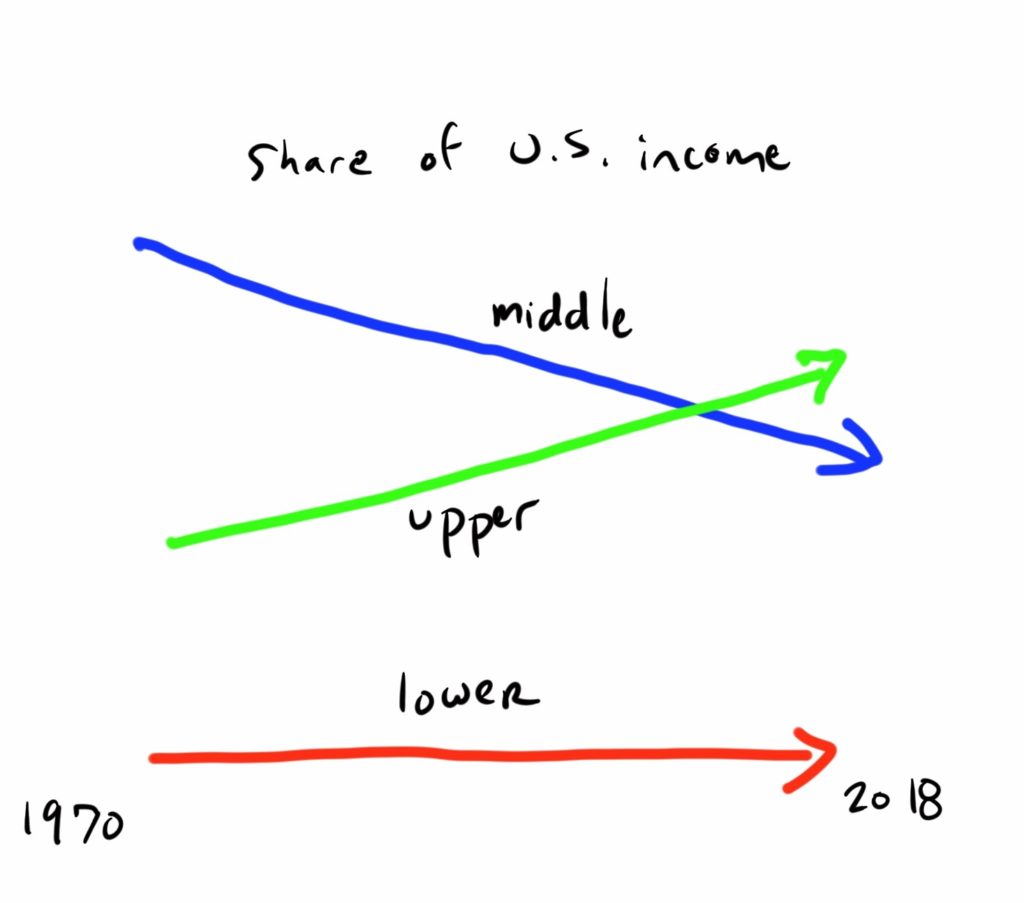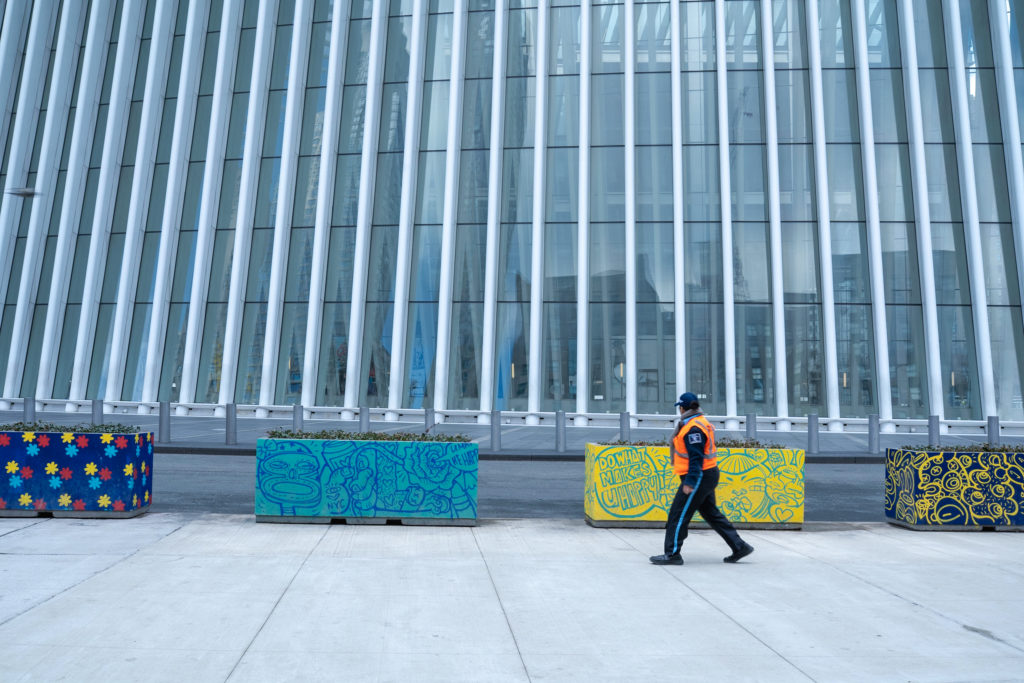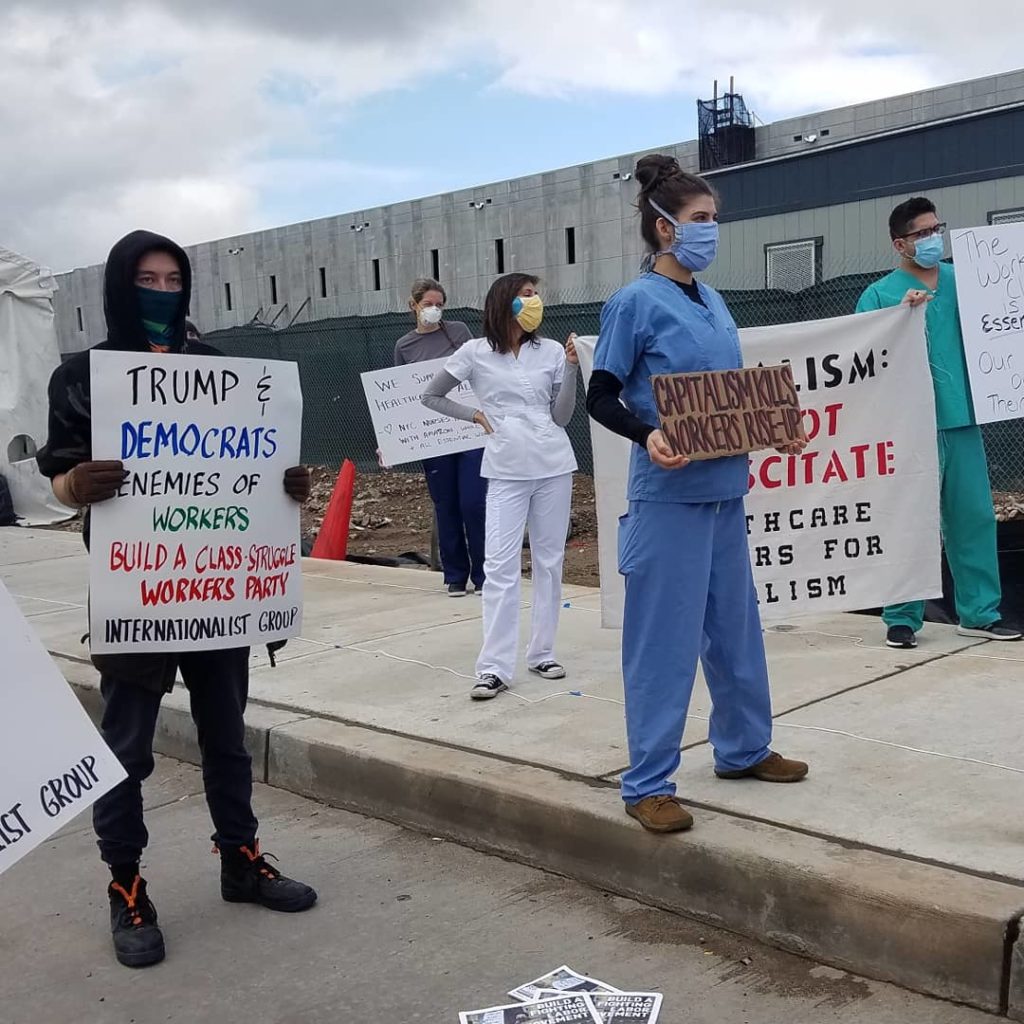We have two major crises in the U.S. right now – the COVID-19 pandemic and the fight for racial equality. Both crises are intertwined with working lives and labor movements.

Makeshift refrigerated trailers outside Bellevue Hospital in Manhattan, April 3rd, 2020. Photo: Brett Wallace
To grasp the developments within labor during these crises, I started with a breakdown of the following categories – jobs, wealth, systemic inequality, debt, and health.
Jobs. The economic depression from the healthcare crisis is a disaster for jobs.
The U.S. labor force is about 165 million people. On May 7th, the labor department reported massive claims in unemployment insurance representing 20.3% and 33.5 million jobs of the U.S. labor force. 1.
Given unemployment only accounts for people actively looking for work, leaving out workers who have experienced a reduction in pay or hours, it does not reflect the true economic devastation. As a comparison, in the great recession of 2009, unemployment reached 10%. During the Great Depression, unemployment rose to 25%.
During the first week of October 2020, another 800,000 Americans filed unemployment. 2.
A report by the University of Chicago Becker Friedman Institute finds there are 3 new hires for every 10 layoffs and it estimates 42% of those job losses will become permanent. 3.
2. Wealth. Wealth is accumulated on the backs of workers. Real wages for working families have been flat for four decades, while we have seen massive increases in productivity. Workers, despite flat wages, have had to contend with increases in housing, transportation, fuel, food, healthcare, and education. While studies show that ~50% of American workers live check to check , and many small businesses on the brink of collapse with only two months of payroll on hand, wealth for the 1% has substantially increased. 4.
Wealth for the 1% is increasing because they own and/or control the means of production, and therefore, receive the surplus provided by proletarian labor force. It is a golden rule of capitalism, that the capitalist class keep these earnings or reinvest them into more production — not into hands of workers.

Drawing from data, Brett Wallace. Data from Pew Research Center. 5.
3. Systemic Inequality. If we look back to the last several decades, every time global capitalism got into trouble, its apologists and saviors jumped in to rescue it through credit expansion and cuts to interest rates, which led to further volatility and crashes.
In the run-up to the slow-moving train wreck which was the 2007-2009 crisis, the expansion of credit, repackaged and sold as financial products, created a massive bubble. The bursting of that bubble brought down global financial corporations and revealed a system built on racial capitalism. In this 2017 lecture, Robin D.G. Kelley provides a introduction to racial capitalism and additional sources.
The racial capitalist system deploys targeted and abstracted financial mechanisms to lure working class and precarious communities further into debt in the form of nefarious marketing, and subprime mortgages, student loans, and other financial products. Underrepresented communities and people of color assume the most debt for college education, only creating additional leverage for a system that does not offer them enough space or opportunities. The banks bet against the repayment of their loans in the knowledge Wall Street would be bailed out from an inevitable crash. The banks and the beneficiaries of these bailouts are not on the side of working people – if they were, they would have bailed out homeowners, instead of foreclosing on homes and forcing the public to endure austerity.
In 2019, the implementation of austerity measures led by corporate powers led to a wave of protests around the world including Lebanon, Hong Kong, El Salvador, Sudan, and Puerto Rico.
4. Debt. The current $6 trillion bailout by the U.S. federal government makes the 2008 bailout, which backstopped the global financial system, seem like child’s play. The second wave of bailouts will take the total U.S. state intervention to about 10 trillion.
While this current bailout does include some provisions to Main Street, it mostly backs up Wall Street. Despite the government claiming relief for small businesses, many have been unable to navigate the Small Business Association’s byzantine relief process, with minority-owned businesses taking the biggest hit.
In addition, larger companies, such as airlines, were given relief in the form of recoverable loans from the Treasury Department. This is a bailout for big business with only a handful of last-minute provisions thrown in for workers, such as keeping them on the payroll for a limited time. A transitional bailout that put workers rights before corporations would include, for example, a provision to help these companies only in return for a public equity stake in them. 6.
5. Health and well-being. Capitalism is a patient in shock. Efforts to keep it alive are creating even greater inequality and wider divisions between those who control and run the capitalist mode of production and those who are subjected to its material conditions.

City worker, Lower Manhattan, April 4th, 2020. Photo: Brett Wallace
Here in New York City, the mayor proposed laying off 22,000 city workers to counter the $9 billion deficit in the city’s budget from the ongoing healthcare and economic crisis. These layoffs would be dealt to “essential workers” who were forced to work during the pandemic. These workers are represented by District Council 37, the largest public union in New York City representing 150,000 workers from architects to zookeepers, responsible for a wide array of vital services. 7.
Despite all the cheers they receive, these frontline workers do not receive the wages, healthcare, and support they deserve. I made the following video during a rally in Foley Square, Manhattan, in September, 2002 in solidarity with District Council 37 city workers.
This is not a new trend. Capitalism reproduces these austerity measures to keep it alive during setbacks. In the 1975 fiscal crisis, New York City cut 51,000 city workers.
Despite the 9 billion dollar budget gap, New York City still spends an huge amount on the NYPD. In fiscal year 2020, expenses for the NYPD will total $10.9 billion. Behind education and social services, this represents third most expensive agency budget in the city’s 97.8 billion budget. 8. The NYPD expenses have been growing steadily over the last decade and now there are major calls to have those expenses defunded given the racial targeting of the NYPD.
As the healthcare crisis unfolds, the inequitable division of earnings and availability of steady work across racial and gender lines is becoming further exposed. In addition to medical workers, it is lower wage workers bearing the brunt of the essential frontline work in this crisis and facing the hazards of exposure to the virus.
Capitalism has privatized and depleted the healthcare system here in the U.S. and around the world. During this public health crisis, workers have continued to show up on the frontline, despite not having access to the appropriate personal protective equipment, healthcare, or the other basic needs, such as housing, that they deserve as a human right. Medical workers are operating in brutal conditions with only sporadic supplies of protective gear. Other essential workers, such as delivery riders, grocery clerks, and postal workers, whose jobs also require human interaction and cannot be done remotely, are facing the risk of infection every day without hazard pay.
Around the country, frontline workers organized to protect themselves. In a protest on May 1, Amazon warehouse workers were joined by nurses and transit workers to fight against unsafe working conditions at the Amazon JFK8 warehouse in Staten Island, New York.

Mayday, JFK8 – Amazon Fulfillment Center. Staten Island, NY. May 1, 2020. Photo: Brett Wallace
The Families First Coronavirus Response Act passed on March 18, 2020, addressed some of these issues, but it did not require compliance from companies like Amazon to provide paid sick leave. Paid sick leave requires compliance of employers of 25-to-499 employees leaving out huge enterprises like Amazon, lots of mid-market firms, and franchises that remain open. 9. And, it wasn’t until Amazon warehouse workers protested that they were even provided with personal protective equipment inside the warehouses.
Dan Patrick, the lieutenant governor of Texas, took the battle of wealth over health to a new level when he appeared on Fox News stating:
“there are more important things than living. And that’s saving this country for my children and my grandchildren and saving this country for all of us.” 10.
This is the grip that capitalism has on society.
However, when businesses open too fast in a health crisis, it is the most vulnerable members of society who suffer, such as the elderly and poor communities without access to isolation or adequate healthcare. It is also frontline services workers, delivery workers, and cashiers, who are disproportionately from black and minority ethnic groups.
This lack of social and financial protection is a hallmark of the neoliberal gig economy, where risk is passed from the corporation onto the individual, despite the absence of a social safety net. The “freedom” promised by the gig economy may feel flexible at times, but it deprives independent workers of health insurance and benefits, dividing them into atomized units to be surveilled. This takes a psychological toll on workers.
As economic provisions dry up, death rates have spiked, not only due to COVID-19, but also in certain demographics due to drug overdoses, suicides, and alcohol-related diseases. 11.The scale of human devastation is far more widespread than the direct harm of COVID-19.
A recent conversation in Strelka mag in early May between Andreas Petrossiants and Franco “Bifo” Berardi explores how this trauma has opened the way for social reprogramming. 12. Berardi writes:
Yesterday, the conditions for revolution were present: the sinking of democracy, the arrogance of the powerful, rampant poverty, violent exploitation, ecological devastation, and widely accessible information about what is going on. But, to quote the Invisible Committee: “Reasons do not make revolutions, bodies do”.
Capitalism is destroying us. Mike Davis, who has studied capitalism’s effects on sustainability e.g. food scarcity, jobs, de-carbonization, and public health, believes we have now entered a new historical epoch. Davis refers to the current state of hyper capitalism as ““an absolute fetter on the development of the productive forces necessary for our species survival.” 13.
This is a time of survival on many dimensions and I am hopeful the growing momentum in the protests around Black Lives Matter, defunding the police, labor strikes for fair contracts and against unsafe conditions and layoffs will create momentum towards change and revolution. That said, there is lots of organizing to be done on the left.
The scope of this crisis raises lots of questions about what kinds of systemic changes are needed to our financial and political economy, how our most ailing citizens will be supported during the economic depression, and how we could exit this system for something more humane.
I am left with open questions that keep me awake at night.
1. I believe the end of capitalism in the U.S. is a matter of when, not if. What will it eventually take to abolish the capitalist system for something new?
2. How will Americans sustain themselves without jobs and relief as they fall below the line of subsistence? How can mutual aid efforts fill a gap? How can we build upon the Heroes act?
3. What are the urgent reforms and transitional demands to make of the current system? For example: defunding the police and increasing social service response; paid sick leave mandates for all employers; abolishment of debt and rent #Cancelrent (Michael Gianaris’s Senate Bill S8125A); universal healthcare; hazard pay for front-line workers; and, internet for all.
4. How can we build on the momentum of current political organizing to get more people involved in down-ballot voting?
5. What new types of autonomous, social grassroots organizations will help us rebuild more equal and just systems?
6. Now that fewer people are working, will our relationship to the problem of labor purchased and sold by capital change?
2. Art worlds
- Council of Economic Advisors, The White House, April Jobs Report Will Show the High Cost of States Shutting Down their Economies, May 7, 2020
- Casselman, Ben. “Staggeringly High’: U.S. Jobless Claims Remained Elevated Last Week“, The New York Times, October 8th, 2020
- Maria Barrero, Jose, et al, “COVID-19 Is Also a Reallocation Shock“, University of Chicago Becker Friedman Institute, June 25, 2020
- First National Bank of Omaha Newsroom, “Study: 53% of U.S. Adults Don’t Have Emergency Fund“, February 19, 2020
- Pew Research Center, “Trends in Income and Wealth Inequality”, January 9, 2020
- Bruenig, Matt. “Reflections on the Coronavirus Economic Relief Bills”, May 7, 2020
- In their words, DC 37 describes their work: “We maintain bridges, parks, roads, and subways. We staff the hospitals, schools, libraries, social service centers, and city colleges. We do the clerical work, the maintenance work, the technical work that keeps this city running.“
- Citizens Budget Commission. “Seven Facts About the NYPD Budget“, June 12, 2020
- Bruenig, Matt. “Reflections on the Coronavirus Economic Relief Bills”, May 7, 2020
- Knodel, Jamie. “Texas Lt. Gov. Dan Patrick suggests he, other seniors willing to die to get economy going again”. March 24, 2020
- Case, Anne, et al. “Deaths of Despair and the Future of Capitalism“, May 4, 2020
- Petrossiants, Andreas. “Franco ‘Bifo’ Berardi: Pandemic and the Reset of the Global Machine“, Strelka Magazine, April 4, 2020
- Kouddous, Sharif Abdel. “Mike Davis On Pandemics, Super-capitalism and the Struggles of Tomorrow“, Portside, April 13, 2020